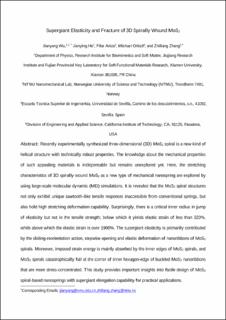| dc.contributor.author | Wu, Jianyang | |
| dc.contributor.author | He, Jianying | |
| dc.contributor.author | Ariza, Pilar | |
| dc.contributor.author | Ortiz, Michael | |
| dc.contributor.author | Zhang, Zhiliang | |
| dc.date.accessioned | 2020-04-29T09:05:33Z | |
| dc.date.available | 2020-04-29T09:05:33Z | |
| dc.date.created | 2020-01-24T06:10:51Z | |
| dc.date.issued | 2020 | |
| dc.identifier.issn | 0376-9429 | |
| dc.identifier.uri | https://hdl.handle.net/11250/2652882 | |
| dc.description.abstract | Recently experimentally synthesized three-dimensional (3D) MoS2 spiral is a new kind of helical structure with technically robust properties. Among them, the mechanical properties of such appealing materials are indispensable but remain unexplored. Here, the stretching characteristics of 3D spirally wound MoS2 as a new type of mechanical nanospring are explored by using large-scale molecular dynamic (MD) simulations. It is revealed that the MoS2 spiral structures not only exhibit unique sawtooth-like tensile responses inaccessible from conventional springs, but also hold high stretching deformation capabilities. Surprisingly, there is a critical inner radius which induces a jump of elasticity but not in the tensile strength; below it yields elastic strain of less than 320%, while above which the elastic strain is over 1900%. The supergiant elasticity is primarily caused by the sliding–reorientation action, stepwise opening and elastic deformation of nanoribbons of MoS2 spirals. Moreover, imposed strain energy is mainly absorbed by the inner edges of MoS2 spirals, and MoS2 spirals catastrophically fail at the corner of the inner hexagon-edge of buckled MoS2 nanoribbons that are more stress-concentrated. This study provides important insights into facile design of MoS2 spiral-based nanosprings with supergiant elongation capability for practical applications. | en_US |
| dc.language.iso | eng | en_US |
| dc.publisher | Springer | en_US |
| dc.title | Supergiant elasticity and fracture of 3D spirally wound MoS2 | en_US |
| dc.type | Peer reviewed | en_US |
| dc.type | Journal article | en_US |
| dc.description.version | acceptedVersion | en_US |
| dc.source.journal | International Journal of Fracture | en_US |
| dc.identifier.doi | 10.1007/s10704-020-00427-5 | |
| dc.identifier.cristin | 1781222 | |
| dc.relation.project | Notur/NorStore: nn9391k | en_US |
| dc.relation.project | Notur/NorStore: NN9110k | en_US |
| dc.description.localcode | This is a post-peer-review, pre-copyedit version of an article. Locked until 3.2.2021 due to copyright restrictions. The final authenticated version is available online at: https://doi.org/10.1007/s10704-020-00427-5 | en_US |
| cristin.unitcode | 194,64,45,0 | |
| cristin.unitname | Institutt for konstruksjonsteknikk | |
| cristin.ispublished | true | |
| cristin.fulltext | postprint | |
| cristin.qualitycode | 1 | |
